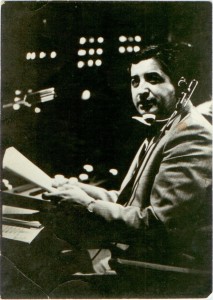The story of Ruben
 Though Ruben Salazar is recognized for his career as one of the most revered and recognized Latino journalists of the 20th century, less is known about his personal life and the early years leading up to his stint as a reporter, bureau chief and columnist for the Los Angeles Times and his work as the news director for the Spanish-language KMEX television station in L.A.
Though Ruben Salazar is recognized for his career as one of the most revered and recognized Latino journalists of the 20th century, less is known about his personal life and the early years leading up to his stint as a reporter, bureau chief and columnist for the Los Angeles Times and his work as the news director for the Spanish-language KMEX television station in L.A.
Salazar was born on March 3, 1928, in Ciudad Juarez, Mexico, and immigrated to Texas with his parents and sister when he was an infant. He grew up in El Paso and graduated from El Paso High School in 1946. Salazar started Texas Western College (now University of Texas El Paso), then served in the United States Army in Europe, before returning to complete his bachelor’s degree in journalism in 1954. During his college years, he wrote a column called “This Shot World” for the school paper and also worked as a managing editor.
For a short time thereafter, Salazar worked as a reporter for the El Paso Herald-Post before moving to Northern California in 1956 to write for the Santa Rosa Press Democrat and later the San Francisco News. In 1959, Salazar moved to Southern California to work for the Los Angeles Times, which would become his mainstay for more than a decade. That same year, he met Sally Robare, his future wife, who worked in the classifieds department at the Times.
During the first years of his career at the Times, Salazar covered local stories including a 1963 series on “Spanish Speaking Angelenos.” In 1965 he became a foreign correspondent covering stories in the Dominican Republic, and before being named Mexico City bureau chief in 1966. From that post he also covered stories in Cuba and Central America before the Times called him back to Los Angeles to cover the Chicano Movement in at the end of 1968.
Salazar followed his boss’s orders and moved his family back to Southern California.
In 1970, Salazar made a major career move and agreed to become the news director for Spanish-language television station KMEX-TV. After taking on the new job, Salazar began writing a weekly column for the Times, where he shared his personal insights and the expressions of others about the conditions confronting Chicanos in the United States.
His career was cut short, though, on August 29, 1970. While covering the Chicano Moratorium in East Los Angeles, Salazar stopped in at the Silver Dollar Bar and Cafe. Sheriffs responding to a call soon surrounded the Silver Dollar and fired a tear gas projectile into the bar, striking and killing Salazar.
In addition to his wife Sally, Ruben was survived by Sally and three young children — Lisa, Stephanie and John.


Thanks for a moment of reflection on the life of a great man.
With respect.
Mario Valdez Juarez ( Teatro Urbano )
I learned about him when I started working in El Paso in 1978 as a legal services attorney. A public housing project on the South Side (Segundo Barrio) was named for him. Our office represented the tenants association there – Valor y Fuerza. Truly a man dedicated to truth and integrity.
[…] was the most prominent Hispanic journalist of his time. He interviewed President Eisenhower, Cesar Chavez, and Robert F. Kennedy. He was the first […]
[…] was the most prominent Hispanic journalist of his time. He interviewed President Eisenhower, Cesar Chavez, and Robert F. Kennedy. He was the first […]